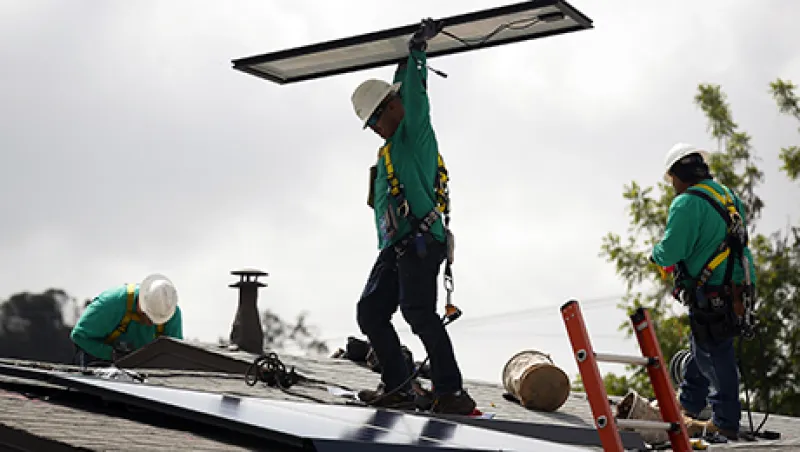Warehouse for Energy Efficiency Loans, or WHEEL, aims to provide homeowners across the U.S. with low-cost financing for home improvements by creating a secondary market for residential clean energy loans via securitization. Launched in April, the WHEEL program, sponsored by the National Association of State Energy Officials, is designed to deliver large-scale, low-cost capital to state and local energy loan programs.
WHEEL facilitates secondary market sales by buying unsecured residential energy efficiency loans that originated in participating state and local programs. The loans are bundled and transferred to a warehouse facility, where they are held until the aggregate amount is large enough to back a bond sale to institutional investors. Proceeds from these note sales will then be used to recapitalize WHEEL, allowing the program to continue buying loans for future rounds of bond issuance.
The WHEEL platform is based on the Keystone Home Energy Loan Program (HELP), which Allentown, Pennsylvania–based AFC First Financial Corp., a nonbank commercial lender that underwrites energy efficient home improvement loans to homeowners, created along with the West Penn Power Sustainable Energy Fund in 2005. The program caught the eye of the Pennsylvania Treasury Department, which began providing capital in 2006 and, in collaboration with AFC and Energy Programs Consortium, a Washington energy policy nonprofit, began developing the WHEEL concept in 2010. Citibank, which provided WHEEL’s initial $100 million credit facility, will act as the arranger of future securitizations. The conduit manager is Renewable Funding, an Oakland, California, company that designs green energy financing programs. The company signed on to the project in 2011.
“[WHEEL] will allow better access to capital, so states won’t have to worry about where the capital will come from,” says Peter Krajsa, chairman and CEO of AFC First. “That’s always been a barrier: How do you tap into the broader capital markets and make cheap financing available to consumers?”
In the past, the two primary options for homeowners looking to make energy efficient retrofits were unsecured bank loans with relatively high rates of interest and, if the program was available in their states, Property Assessed Clean Energy (PACE) loans, a type of secured lending funded via the municipal debt market, which were first implemented in 2008.
WHEEL was seeded last month with an initial 1,500 loans to Pennsylvania homeowners totaling roughly $13 million. At present it holds loans in the neighborhood of $20 million, with Kentucky also participating, says Cisco DeVries, president and CEO of Renewable Funding, who also pioneered the PACE loan program. The target for WHEEL’s first offering of asset-backed notes is roughly $50 million, with the announcement expected this fall. The exact date depends on variables such as market conditions and how fast the loans come into the warehouse.
“What we know from the market is that there’s enormous appetite for these loans,” says DeVries. “We’re not concerned about having a sufficient number of buyers for the security. We want to have a large enough pool that we can make all the machinery work correctly and get good pricing information. Then we’ll start doing larger, more regular securitizations later.”
DeVries expects a third state to join WHEEL in the next month or two, and an additional four or five states to sign on by the end of the year. The hope is for nationwide participation next year.
“Most of these loans in the past have been funded by local capital sources that have limits that are much lower than what the market requires; Pennsylvania is a perfect example,” says Keith Welks, Pennsylvania deputy state treasurer for fiscal operations. The state had committed to offering energy efficiency loans totaling as much as $40 million at a time. “At those levels, we were exhausting the amount of money that we could commit for this purpose,” Welks adds. “But the demand was going to continue. So our problem was, if we didn’t want to abruptly end the program, we needed to find a sustainable source of capital. And we couldn’t do that on our own.”
Indeed, the need is evident. Consulting firm McKinsey & Co. reported in 2009 that the U.S. could reduce energy consumption in homes roughly 23 percent by 2020 with an up-front investment of $520 billion. The cutback in energy use would translate into an annual decrease of 1.1 gigatons in greenhouse gas emissions, roughly the amount emitted by all passenger vehicles and light trucks in the U.S.
And how do energy efficiency loans stack up?
Quite well, says AFC First’s Krajsa, despite the fact that the loans are unsecured and there’s only about eight years of performance data available. But in that time, he says, these loans have performed significantly better than other types of unsecured consumer asset classes, with annual overall delinquency and losses of about 1 percent.
There are a few reasons for the low delinquency rate, Krajsa says. These fixed-rate, typically ten-year loans are taken out by what he calls “thinking consumers,” borrowers who are making a forward-looking improvement to their homes. And because they are closed-end installment loans, they tend to have lower delinquencies than, say, credit cards. In addition, the work on the home is done through an approved contractor network, and the contractor is not paid until it’s clear the customer is 100 percent satisfied. “So you eliminate a lot of buyer’s remorse,” says Krajsa. Finally, the lower energy bills reaped by the improvements free up cash that helps pay back the loans.
Get more on fixed income.






